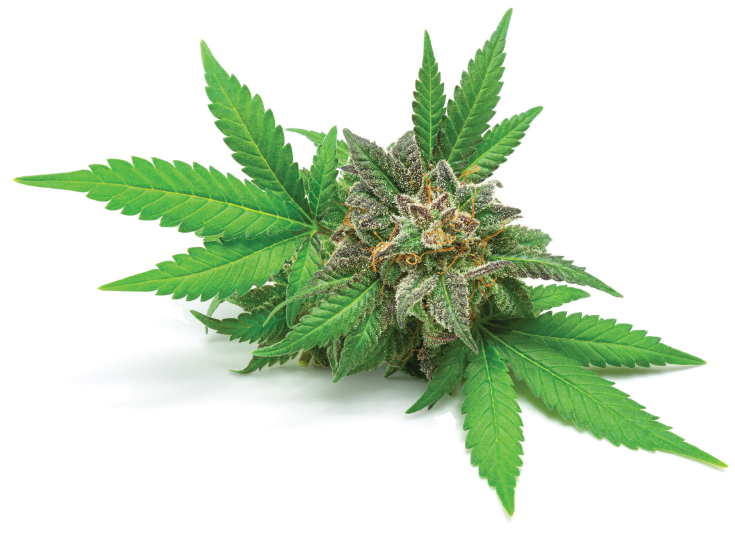
Nirupa Raghunathan, MD

Jyothirmai Gubili, MS
The ASCO Post’s Integrative Oncology series is intended to facilitate the availability of evidence-based information on integrative and complementary therapies sometimes used by patients with cancer. In this article, Nirupa Raghunathan, MD, and Jyothirmai Gubili, MS, focus on the increasing use of cannabis by patients with cancer for symptom management and its potential therapeutic benefits as well as detrimental effects.
Scientific Name: Cannabis sativa
Common names: More than 1,000 including marijuana, ganja, bhang, weed, pot, grass, reefer, and hash
Overview
Cannabis is among the most widely used illicit and highly controversial agents due to its potential for abuse. Detrimental effects associated with its use include risk of addiction, serious adverse events, and withdrawal syndrome.
Cannabis preparations are obtained from the flowers, leaves, and resinous extract of the Cannabis sativa plant, which is cultivated around the world. These preparations are taken orally, by vaporizing or smoking. In addition, cannabis tinctures, teas, and oil-based extracts, which can be added to food products, are also popular. Active compounds of cannabis were identified as the cannabinoids delta-9-tetrahydrocannabinol (THC), the main psychoactive component; and cannabidiol (CBD), a nonpsychoactive compound.
The Science
Cannabis has been investigated for its potential therapeutic effects in patients with cancer, with systematic reviews reporting benefits against chemotherapy-induced nausea and vomiting.1,2 Two U.S. Food and Drug Administration (FDA)-approved synthetic cannabinoids, dronabinol and nabilone, are now recommended by ASCO for alleviating nausea and vomiting resistant to standard treatment.3 Dronabinol is also approved for the treatment of anorexia associated with weight loss in patients with AIDS.
Guest Editor

Jun J. Mao, MD, MSCE
Integrative Oncology is guest edited by Jun J. Mao, MD, MSCE, Laurance S. Rockefeller Chair in Integrative Medicine and Chief of Integrative Medicine Service at Memorial Sloan Kettering Cancer Center, New York.
Furthermore, data suggest the effectiveness of THC and nabiximols spray, a cannabis extract, for relieving pain4; and of dronabinol, for reducing paraneoplastic night sweats.5 But a clinical trial did not find any benefits with cannabis for improving cancer-related anorexia-cachexia syndrome.4
In addition to its utility in cancer symptom management, cannabis may have an impact on the disease as well. A cannabinoid resin extract was found to affect dose-dependent disease control in a patient with acute lymphoblastic leukemia.6 However, concurrent use of cannabis during immunotherapy with nivolumab has been correlated with an attenuated tumor response rate in patients with advanced melanoma, non–small cell lung cancer, and clear cell renal carcinoma.7 Data from a randomized study evaluating the effects of an oromucosal cannabis extract in patients with glioblastoma have yet to be published.8
In settings unrelated to cancer, an oral CBD solution was reported to be effective in reducing the frequency of seizures in patients with Lennox-Gastaut syndrome or Dravet syndrome, two rare types of epilepsy.9 Subsequently, the formulation was approved for use by the FDA in these patients and in those with tuberous sclerosis complex.10,11 Also, the American Academy of Neurology issued a Summary of Systematic Reviews for Clinicians highlighting the utility of cannabis in decreasing pain and spasticity associated with multiple sclerosis.12 However, definitive evidence is lacking to support the use of cannabis for addressing sleep disorders, Tourette syndrome, or loss of appetite.1 Whether cannabinoids can help treat symptoms of Parkinson’s and Huntington’s diseases, dyskinesia, irritable bowel syndrome, and addiction also remains unclear.13 Studies to assess their benefits against chronic, non–cancer-related pain produced mixed results.14,15
Given the emerging data as well as the potential for abuse and addiction, further research is needed to fully understand the therapeutic potential of cannabis13 and to inform medical cannabis policy.
Adverse Reactions
Dizziness, dry mouth, nausea, fatigue, somnolence, euphoria, vomiting, disorientation, drowsiness, confusion, loss of balance, and hallucination are among the short-term effects of medical cannabinoids.1
Inhalation of cannabis products has been associated with myocardial infarction, sudden cardiac death, cardiomyopathy, stroke, transient ischemic attack, and cannabis arteritis.16
Chronic bronchitis has been associated with the regular use of cannabis products.17
There is a risk of addiction with the use of cannabis.18,19
Cannabis use can elevate the risk of rare but life-threatening cardiac dysrhythmia,20 acute coronary syndrome, and chronic cardiovascular disease.21
Withdrawal syndrome following cessation of cannabis use. Symptoms include irritability, sleeping difficulties, dysphoria, craving, and anxiety.22
OF NOTE
Physicians should be aware of the growing patient interest in cannabis products, the adverse effects associated with their use, and the risk of addiction.
Fatalities following chronic cannabis use were attributed to cannabis hyperemesis syndrome, characterized by cyclic attacks of nausea and vomiting.23 In a case report, benzodiazepines were reported to relieve the symptoms of cannabis hyperemesis syndrome.24
Noteworthy is the finding that synthetic cannabinoid drugs may inflict more harm compared with natural cannabis. Reported adverse effects include respiratory difficulties, hypertension, tachycardia, chest pain, muscle twitches, acute renal failure, anxiety, agitation, psychosis, suicidal ideation, and cognitive impairment.25
Herb-Drug Interactions
Cytochrome P450 Substrates: Smoking cannabis has been shown to induce CYP1A2, with additive effects when it is smoked together with tobacco, and may affect the intracellular concentration of drugs metabolized by this enzyme.26
Cytochrome P450 Substrates: CBD strongly inhibits CYP2C1927 and CYP2C928 in vitro. Clinical significance of this effect is not known.
Immunotherapy (Nivolumab): In an observational study, concurrent use with cannabis has been associated with a decrease in treatment response rates in cases of advanced melanoma, non–small cell lung cancer, and clear cell renal carcinoma.7,29
Warfarin: THC and CBD both elevate international normalized ratio levels.30
Fluoxetine: Mania has been reported following co-administration with cannabis.31
Disulfiram: Delirium and hypomania were reported after simultaneous administration with cannabis.32,33

Amphetamines, Cocaine, Atropine, and Sympathomimetic Agents: Cardiotoxicity has occurred with cannabis via additive hypertension and tachycardia.34,35
Sedatives or Hypnotics: Sedation and significant pharmacodynamic interactions may occur when taken with cannabis through the potentiation of central effects.36
P-glycoprotein Substrates: CBD inhibits P-glycoprotein and may affect metabolism of certain drugs.37 Clinical significance remains to be determined.
Clobazam: CBD was found to increase clobazam levels in children with epilepsy.38
Buprenorphine: Use of cannabis reduced the formation of norbuprenorphine and elevated buprenorphine and norbuprenorphine levels in healthy individuals on opioid maintenance therapy substituted with buprenorphine. This interaction can affect an increase or alter opioid activity and risk of intoxication.39
Summary
Although highly controversial, cannabis has been legalized in 36 states and Washington, DC, for medicinal use, with 16 states and DC also approving its recreational use. Many clinicians are asked questions about medical cannabis, and studies have showed that a majority of providers believe cannabis can be helpful for medical symptoms, but they also are often unprepared to answer questions about its use.39,40 Continued study and informed providers are needed to support appropriate counseling and use of cannabis.
DISCLOSURE: Dr. Raghunathan and Ms. Gubili reported no conflicts of interest.
REFERENCES
1. Whiting PF, Wolff RF, Deshpande S, et al: Cannabinoids for medical use: A systematic review and meta-analysis. JAMA 313:2456-2473, 2015.
2. Smith LA, Azariah F, Lavender VTC, et al: Cannabinoids for nausea and vomiting in adults with cancer receiving chemotherapy. Cochrane Database Syst Rev 2015(11):CD009464, 2015.
3. Hesketh PJ, Kris MG, Basch E, et al: Antiemetics: American Society of Clinical Oncology Clinical Practice Guideline Update. J Clin Oncol 35:3240-3261, 2017.
4. Strasser F, Luftner D, Possinger K, et al: Comparison of orally administered cannabis extract and delta-9-tetrahydrocannabinol in treating patients with cancer-related anorexia-cachexia syndrome: A multicenter, phase III, randomized, double-blind, placebo-controlled clinical trial from the Cannabis-In-Cachexia-Study-Group. J Clin Oncol 24:3394-3400, 2006.
5. Carr C, Vertelney H, Fronk J, et al: Dronabinol for the treatment of paraneoplastic night sweats in cancer patients: A report of five cases. J Palliat Med 22:1221-1223, 2019.
6. Singh Y, Bali C: Cannabis extract treatment for terminal acute lymphoblastic leukemia with a Philadelphia chromosome mutation. Case Rep Oncol 6:585-592, 2013.
7. Taha T, Meiri D, Talhamy S, et al: Cannabis impacts tumor response rate to nivolumab in patients with advanced malignancies. Oncologist 24:549-554, 2019.
8. GW Pharmaceuticals achieves positive results in phase 2 proof of concept study in glioma. Feburary 7, 2017. Available at https://www.gwpharm.com/about-us/news/gw-pharmaceuticals-achieves-positive-results-phase-2-proof-concept-study-glioma. Accessed April 20, 2021.
9. O’Connell BK, Gloss D, Devinsky O: Cannabinoids in treatment-resistant epilepsy: A review. Epilepsy Behav 70(Pt B):341-348, 2017.
10. U.S. Food and Drug Administration: FDA approves first drug comprised of an active ingredient derived from marijuana to treat rare, severe forms of epilepsy. June 25, 2018. Available at https://www.fda.gov/news-events/press-announcements/fda-approves-first-drug-comprised-active-ingredient-derived-marijuana-treat-rare-severe-forms. Accessed April 20, 2021.
11. U.S. Food and Drug Administration: FDA approves new indication for drug containing an active ingredient derived from cannabis to treat seizures in rare genetic disease. July 31, 2020. Available at https://www.fda.gov/news-events/press-announcements/fda-approves-new-indication-drug-containing-active-ingredient-derived-cannabis-treat-seizures-rare#:~:text=Today%2C%20the%20U.S.%20Food%20and,year%20of%20age%20and%20older. Accessed April 20, 2021.
12. American Academy of Neurology: Efficacy and safety of the therapeutic use of medical marijuana (cannabis) in selected neurologic disorders. 2014. Available at www.aan.com/Guidelines/home/GetGuidelineContent/651. Accessed April 20, 2021.
13. Abrams DI: The therapeutic effects of Cannabis and cannabinoids: An update from the National Academies of Sciences, Engineering and Medicine report. Eur J Intern Med 49:7-11, 2018.
14. Lynch ME, Campbell F: Cannabinoids for treatment of chronic non-cancer pain: A systematic review of randomized trials. Br J Clin Pharmacol 72:735-744, 2011.
15. Campbell G, Hall WD, Peacock A, et al: Effect of cannabis use in people with chronic non-cancer pain prescribed opioids: Findings from a 4-year prospective cohort study. Lancet Public Health 3:e341-e350, 2018.
16. Thomas BF: Interactions of cannabinoids with biochemical substrates. Subst Abuse 11:1178221817711418, 2017.
17. Tashkin DP: Effects of marijuana smoking on the lung. Ann Am Thorac Soc 10:239-247, 2013.
18. Hall W, Degenhardt L: Adverse health effects of non-medical cannabis use. Lancet 374:1383-1391, 2009.
19. Lopez-Quintero C, Pérez de los Cobos J, Hasin DS, et al: Probability and predictors of transition from first use to dependence on nicotine, alcohol, cannabis, and cocaine: Results of the National Epidemiologic Survey on Alcohol and Related Conditions (NESARC). Drug Alcohol Depend 115:120-130, 2011.
20. Richards JR, Blohm E, Toles KA, et al: The association of cannabis use and cardiac dysrhythmias: A systematic review. Clin Toxicol (Phila) 58:861-869, 2020.
21. Richards JR, Bing ML, Moulin AK, et al: Cannabis use and acute coronary syndrome. Clin Toxicol (Phila) 57:831-841, 2019.
22. Gorelick DA, Levin KH, Copersino ML, et al: Diagnostic criteria for cannabis withdrawal syndrome. Drug Alcohol Depend 123:141-147, 2012.
23. Nourbakhsh M, Miller A, Gofton J, et al: Cannabinoid hyperemesis syndrome: Reports of fatal cases. J Forensic Sci 64:270-274, 2019.
24. Kheifets M, Karniel E, Landa D, et al: Resolution of cannabinoid hyperemesis syndrome with benzodiazepines: A case series. Isr Med Assoc J 21:404-407, 2019.
25. Cohen K, Weinstein AM: Synthetic and non-synthetic cannabinoid drugs and their adverse effects: A review from public health prospective. Front Public Health 6:162, 2018.
26. Anderson GD, Chan LN: Pharmacokinetic drug interactions with tobacco, cannabinoids and smoking cessation products. Clin Pharmacokinet 55:1353-1368, 2016.
27. Jiang R, Yamaori S, Okamoto Y, et al: Cannabidiol is a potent inhibitor of the catalytic activity of cytochrome P450 2C19. Drug Metab Pharmacokinet 28:332-338, 2013.
28. Yamaori S, Koeda K, Kushihara M, et al: Comparison in the in vitro inhibitory effects of major phytocannabinoids and polycyclic aromatic hydrocarbons contained in marijuana smoke on cytochrome P450 2C9 activity. Drug Metab Pharmacokinet 27:294-300, 2012.
29. Taha T, Talhamy S, Wollner M, et al: The effect of cannabis use on tumor response to nivolumab in patients with advanced malignancies. ESMO 2017 Congress. Abstract 1038. Presented September 9, 2017.
30. Damkier P, Lassen D, Christensen MMH, et al: Interaction between warfarin and cannabis. Basic Clin Pharmacol Toxicol 124:28-31, 2019.
31. Stoll AL, Cole JO, Lukas SE: A case of mania as a result of fluoxetine-marijuana interaction. J Clin Psychiatry 52:280-281, 1991.
32. Mackie J, Clark D: Cannabis toxic psychosis while on disulfiram. Br J Psychiatry 164:421, 1994.
33. Lacoursiere RB, Swatek R: Adverse interaction between disulfiram and marijuana: A case report. Am J Psychiatry 140:243-244, 1983.
34. Foltin RW, Fischman MW, Pedroso JJ, et al: Marijuana and cocaine interactions in humans: Cardiovascular consequences. Pharmacol Biochem Behav 28:459-464, 1987.
35. Benowitz NL, Jones RT: Prolonged delta-9-tetrahydrocannabinol ingestion: Effects of sympathomimetic amines and autonomic blockades. Clin Pharmacol Ther 21:336-342, 1977.
36. Arellano AL, Papaseit E, Romaguera A, et al: Neuropsychiatric and general interactions of natural and synthetic cannabinoids with drugs of abuse and medicines. CNS Neurol Disord Drug Targets 16:554-566, 2017.
37. Zhu HJ, Wang JS, Markowitz JS, et al: Characterization of P-glycoprotein inhibition by major cannabinoids from marijuana. J Pharmacol Exp Ther 317:850-857, 2006.
38. Geffrey AL, Pollack SF, Bruno PL, et al: Drug-drug interaction between clobazam and cannabidiol in children with refractory epilepsy. Epilepsia 56:1246-1251, 2015.
39. Hewa-Gamage D, Blaschke S, Drosdowsky A, et al: A cross-sectional survey of health professionals’ attitudes toward medicinal cannabis use as part of cancer management. J Law Med 26:815-824, 2019.
40. Philpot LM, Ebbert JO, Hurt RT: A survey of the attitudes, beliefs and knowledge about medical cannabis among primary care providers. BMC Fam Pract 20:17, 2019.
Dr. Raghunathan is a Pediatric Integrative Medicine Specialist and Ms. Gubili is an Editor, both at theIntegrative Medicine Service, Memorial Sloan Kettering Cancer Center, New York.

